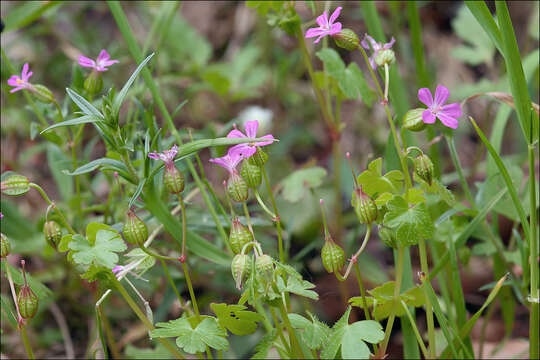Geranium-lucidum_2

Description:
Geranium lucidum L.Shining Crane's-bill, DE: Glzender StorchschnabelSlo.: bleea krvomonicaDat.: May 16. 2016Lat.: 46.35133 Long.: 13.69344Code: Bot_957/2016_DSC2154Habitat: semiruderal road side, next to river bed, calcareous, sandy ground; partly shady, humid place (air and ground); average precipitations ~ 3.000 mm/year, average temperature 7-9 deg C, elevation 520 m (1.700 feet), alpine phytogeographical region. Substratum: soil.Place: Lower Trenta valley, between villages Soa and Trenta, between main road to Vri pass and river Soa, next to Trenta 46 farmhouse, East Julian Alps, Posoje, Slovenia EC. Comment: Geranium lucidum is a Mediterranean plant growing in the whole Mediterranean region but also outside it. In the Alps one can find it in their far west part, on their south edge in north Italy around Bergamo and in their extreme northeast part in Niedersterreich, where it is extremely rare and facing extinction (Ref.6). It grows also in Apennines, Pyreneans and Carpathians as well as in Balkan mountains. It grows from low land to montane elevations (Ref.2). To my knowledge this find seems to be the first in the Julian Alps. Flora Alpina (2004) Ref.2 doesn't refer presence of Geranium lucidum in Slovenian Alps. Also Slovenian key (2007), Ref.3 and Gradivo za Atlas, Ref.4 does not show its presence in Alpine phytogeographical region of Slovenia. The closest reference I found is in Nuovo Atlante... (2002), Ref.5 where it has been found in UTM square 6746 in Outer Julian Prealps near Tarcento, Italy. The site is still quite far from this location. The habitat of this find is mostly semi-ruderal; just next to the main asphalt road from town Bovec to Vri pass, around the abandoned farmhouse Soa 46 and on a large pile of rocks gathered together during cleaning grassland around the farmhouse. It is almost sure that the site is sub-spontaneous, although I have no idea how could the plants come to this place. First World War with its two years of fixed front line crossing the region, which provenly introduced several new species to Slovenia through huge quantities of hay for army horses brought in from all parts of Austro-Hungarian empire, could hardly be an explanation. The plant is not showy and is considered a weed in horticulture, so nobody would plant it intentionally. The most probable way seems to be to be introduced by other garden plants, which still grow 'wild' around the abandoned house. The population is large counting several hundred flowering plants in a region of about 100 x 40 m.Ref.:(1) Identification confirmed by Dr. Igor Dakskobler, Natural History Institute Jovan Hadi, SAZU.(2) D. Aeschimann, K. Lauber, D.M. Moser, J.P. Theurillat, Flora Alpina, Vol. 1., Haupt (2004), p 1060.(3) A. Martini et all., Mala Flora Slovenije (Flora of Slovenia - Key) (in Slovenian), Tehnina Zaloba Slovenije (2007), p 350. (4) N. Jogan (ed.), Gradivo za Atlas flore Slovenije (Materials for the Atlas of Flora of Slovenia), CKSF (2001), p 179(5) L. Poldini, Nuovo Atlante corologico delle piante vascolari nel Friuli Venezia Giulia, University of Trieste (2002), p 227.(6) M.A. Fischer, W. Adler, K. Oswald, Exkursionsflora fr sterreich, Liechtenstein und Sdtirol, LO Landesmuseen, Linz, Austria (2005), p 412.Nikon D700 / Nikkor Micro 105mm/f2.8
Included On The Following Pages:
- Life (creatures)
- Cellular (cellular organisms)
- Eukaryota (eukaryotes)
- Archaeplastida (plants)
- Chloroplastida (green plants)
- Streptophyta
- Embryophytes
- Tracheophyta (ferns)
- Spermatophytes (seed plants)
- Angiosperms (Dicotyledons)
- Eudicots
- Superrosids
- Rosids
- Geraniales
- Geraniaceae (storksbill family)
- Geranium (geranium)
- Geranium lucidum (shining geranium)
This image is not featured in any collections.
Source Information
- license
- cc-by-nc-sa
- copyright
- Amadej Trnkoczy
- photographer
- Amadej Trnkoczy
- original
- original media file
- visit source
- partner site
- Flickr Group
- ID


